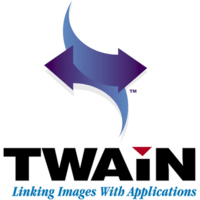TWAIN
 | |
| Original author(s) | TWAIN Working Group |
|---|---|
| Developer(s) | TWAIN Working Group |
| Initial release | February 1992 |
| Stable release | 2.3 / 21 November 2013 |
| Operating system | Linux, OS X, Microsoft Windows |
| Platform | x86, x86-64, PowerPC |
| Type | Application programming interface |
| License | LGPL (Data Source Manager only) |
| Website |
www |
| Standard(s) | TWAIN |
TWAIN is an applications programming interface (API) and communications protocol that regulates communication between software and digital imaging devices, such as image scanners and digital cameras.
TWAIN is not a hardware-level protocol; it requires a driver called Data Source for each device.[1]
History
The design of TWAIN began in January 1991. The TWAIN group originally launched in 1992 by several members of the imaging industry, with the intention of standardizing communication between image handling software and hardware.[2] Review of the original TWAIN Developer’s Toolkit occurred from April, 1991 through January, 1992.[3]
The word TWAIN is not officially an acronym, but it is a backronym. The official website notes that "the word TWAIN is from Kipling's The Ballad of East and West — '...and never the twain shall meet...' — reflecting the difficulty, at the time, of connecting scanners and personal computers. It was up-cased to TWAIN to make it more distinctive. This led people to believe it was an acronym, and then to a contest to come up with an expansion. None was selected, but the entry Technology Without an Interesting Name continues to haunt the standard."[4]
| Version | Release date | Changes |
|---|---|---|
| 1.0 | February 1992 |
|
| 1.5 | May 1993 |
|
| 1.6 | 5 February 1996 |
|
| 1.7 | 19 August 1997 |
|
| 1.8 | 22 October 1998 |
|
| 1.9 | 20 January 2000 |
|
| 2.0 | 22 February 2008 |
|
| 2.1 | 8 July 2009 |
|
| 2.2 | 16 February 2012 |
|
| 2.3 | 21 November 2013 |
|
Vision statement
The TWAIN Working Group is a not-for-profit organization which represents the imaging industry. TWAIN's purpose is to provide and foster a universal public standard which links applications and image acquisition devices. The ongoing mission of the organization is to continue to enhance the standard to accommodate future technologies.
Objectives
Objectives of the TWAIN Working Group and standard include:
- Ensure image-handling software and hardware compatibility
- Keep the specification current with the state of current software and hardware while maintaining backward compatibility
- Provide multiple-platform support
- Maintain and distribute a no-charge developer's toolkit
- Ensure ease of implementation
- Encourage widespread adoption
- Open Source Data Source Manager
- LGPL Open Source License
- BSD Open Source Sample Application and Sample Data Source Application
Supported technologies
TWAIN provides support for:
- Production, high-speed scanning
- ICC Color profiles
- Digital cameras
- Multiple operating system platforms including Windows, Mac OS, and Linux
TWAIN Working Group membership
Today the TWAIN standard, including the specification, data source manager and sample code, are maintained by the not-for-profit organization TWAIN Working Group.
Board and associate members of the TWAIN Working Group include:
- Atalasoft, a Kofax company.
- Avision Inc.
- Dynamsoft Corporation
- Kodak Alaris, Inc.
- Fujitsu Computer Products of America
- JFL Peripheral Solutions, Inc.
- Epson, Inc.
- Hewlett-Packard, Inc.
- InoTec GmbH - Organisationssysteme
- Picture Elements
- Ambir Technology
See also
- Windows Image Acquisition (WIA)
- Scanner Access Now Easy (SANE)
- Image and Scanner Interface Specification (ISIS)
References
- ↑ "TWAIN". Eztwain.com. Retrieved 2013-06-14.
- ↑ What is the TWAIN Initiative?Archived March 8, 2012 at the Wayback Machine
- ↑ TWAIN docs indexArchived September 27, 2011 at the Wayback Machine
- ↑ "The TWAIN Forum • View topic - What is TWAIN an acronym for?". Twainforum.org. Retrieved 2013-06-14.
External links
- TWAIN Working Group
- Overview of TWAIN and TWAIN Data Sources
- TWAIN: Linking Applications and Images - A White Paper by Hewlett Packard
- 9 Rules for Evaluating Web TWAIN Components - A White Paper by Dynamsoft
- ScanTWAIN Open Source Example of using TWAIN 2.0 from Linux
- TWAIN 2.3 specification
This article is based on material taken from the Free On-line Dictionary of Computing prior to 1 November 2008 and incorporated under the "relicensing" terms of the GFDL, version 1.3 or later.